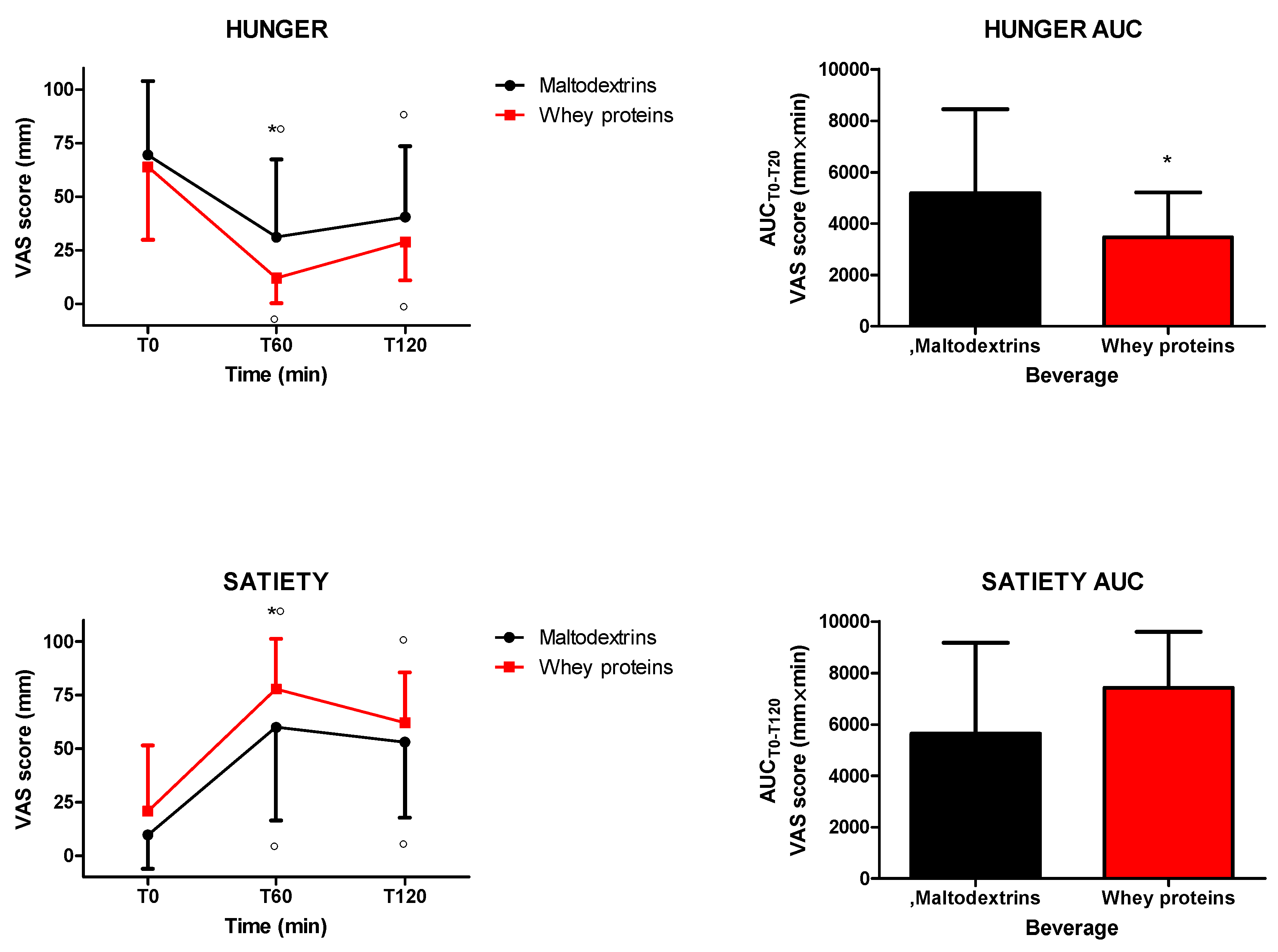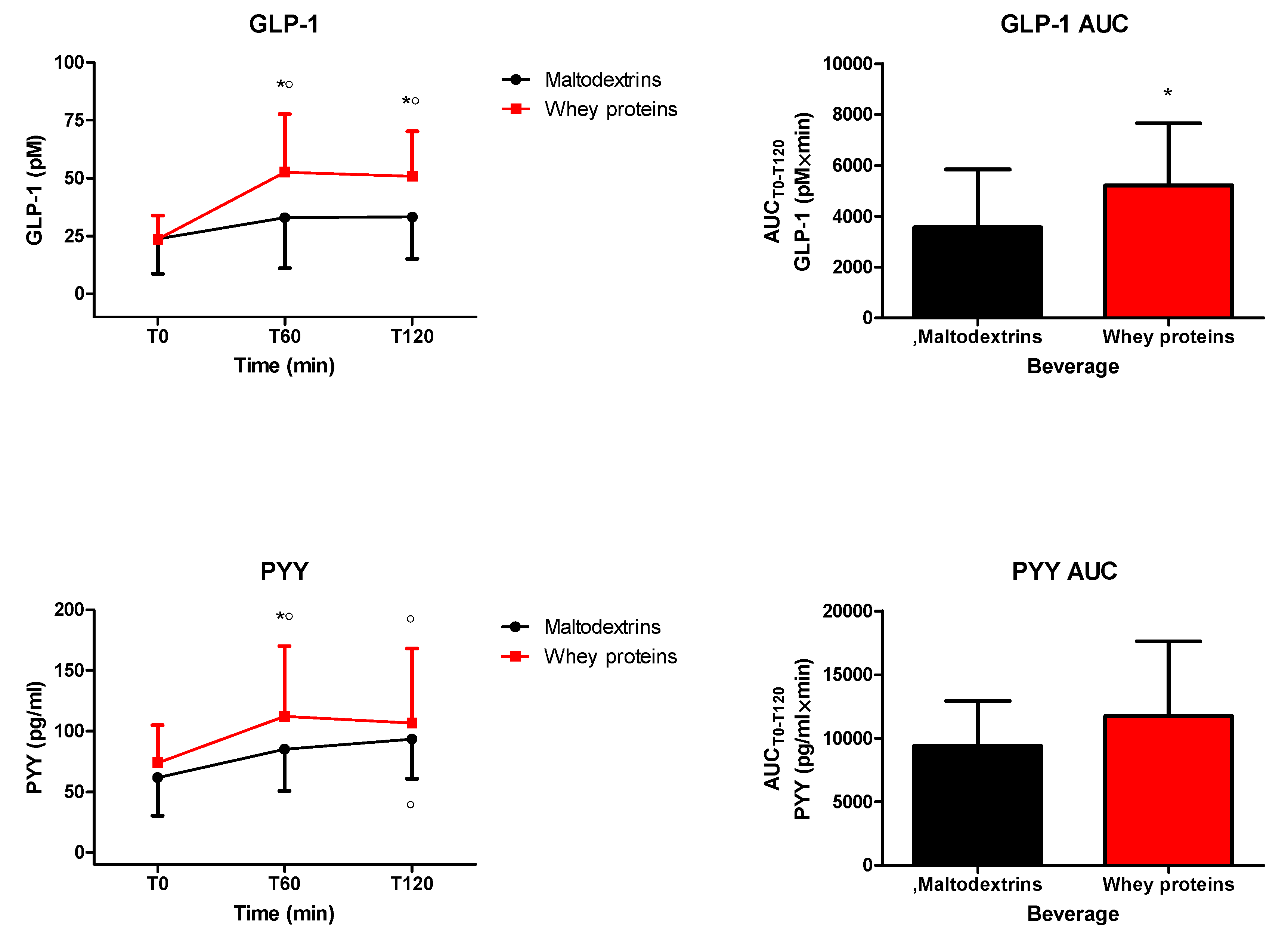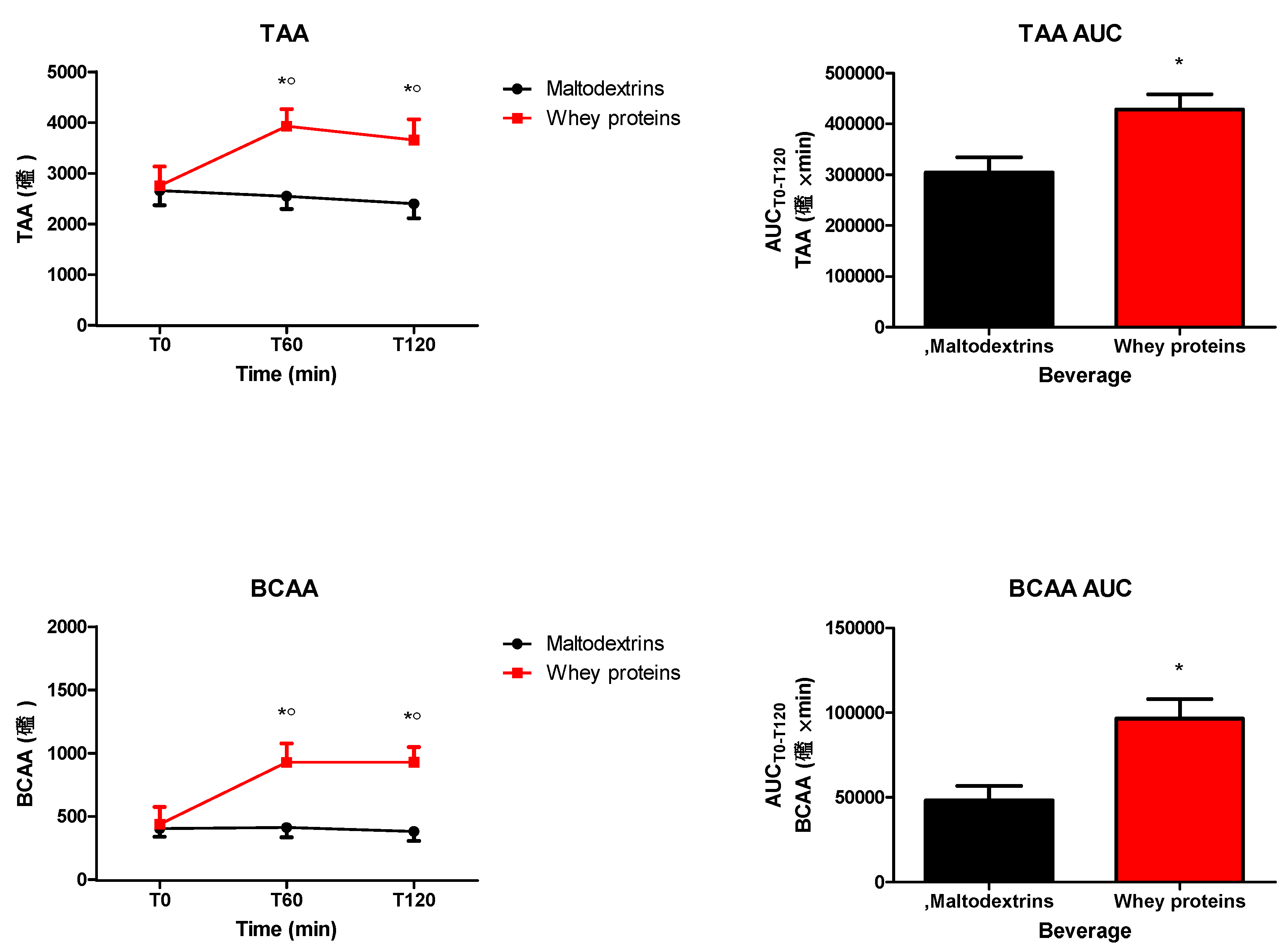The Appetite−Suppressant and GLP-1-Stimulating Effects of Whey Proteins in Obese Subjects are Associated with Increased Circulating Levels of Specific Amino Acids
Abstract
1. Introduction
2. Materials and Methods
2.1. Patients and Experimental Protocol
2.2. Blood Sampling and Biochemical Measurements
2.3. Statistical Analyses
3. Results
4. Discussion
5. Conclusions
Author Contributions
Funding
Acknowledgments
Conflicts of Interest
Abbreviations
| BCAA | branched-chain amino acid |
| BMI | body mass index |
| CV | coefficient of variation |
| DPP-IV | dipeptidyl protease IV |
| FFM | fat-free mass |
| FM | fat mass |
| GLP-1 | glucagon-like peptide 1 |
| GMP | glycomacropeptide |
| PYY | peptide YY |
| SD | standard deviation |
| TAA | total amino acids |
| VAS | visual analogue scale |
References
- Yannakoulia, M.; Poulimeneas, D.; Mamalaki, E.; Anastasiou, C.A. Dietary modifications for weight loss and weight loss maintenance. Metabolism 2019, 92, 153–162. [Google Scholar] [CrossRef] [PubMed]
- Westerterp−Plantenga, M.S.; Lemmens, S.G.; Westerterp, K.R. Dietary protein—Its role in satiety, energetics, weight loss and health. Br. J. Nutr. 2012, 108 (Suppl. S2), S105–S112. [Google Scholar]
- Soenen, S.; Westerterp−Plantenga, M.S. Proteins and satiety: Implications for weight management. Curr. Opin. Clin. Nutr. Metab. Care 2008, 11, 747–751. [Google Scholar] [CrossRef] [PubMed]
- Bendtsen, L.Q.; Lorenzen, J.K.; Bendsen, N.T.; Rasmussen, C.; Astrup, A. Effect of dairy proteins on appetite, energy expenditure, body weight, and composition: A review of the evidence from controlled clinical trials. Adv. Nutr. 2013, 4, 418–438. [Google Scholar] [CrossRef] [PubMed]
- Luhovyy, B.L.; Akhavan, T.; Anderson, G.H. Whey proteins in the regulation of food intake and satiety. J. Am. Coll. Nutr. 2007, 26, 704S–712S. [Google Scholar] [CrossRef] [PubMed]
- Rigamonti, A.E.; Leoncini, R.; Casnici, C.; Marelli, O.; Col, A.; Tamini, S.; Lucchetti, E.; Cicolini, S.; Abbruzzese, L.; Cella, S.G.; et al. Whey Proteins Reduce Appetite, Stimulate Anorexigenic Gastrointestinal Peptides and Improve Glucometabolic Homeostasis in Young Obese Women. Nutrients 2019, 11, 247. [Google Scholar] [CrossRef] [PubMed]
- Giezenaar, C.; Luscombe−Marsh, N.D.; Hutchison, A.T.; Standfield, S.; Feinle−Bisset, C.; Horowitz, M.; Chapman, I.; Soenen, S. Dose−Dependent Effects of Randomized Intraduodenal Whey−Protein Loads on Glucose, Gut Hormone, and Amino Acid Concentrations in Healthy Older and Younger Men. Nutrients 2018, 10, 78. [Google Scholar] [CrossRef]
- Giezenaar, C.; Trahair, L.G.; Luscombe−Marsh, N.D.; Hausken, T.; Standfield, S.; Jones, K.L.; Lange, K.; Horowitz, M.; Chapman, I.; Soenen, S. Effects of randomized whey−protein loads on energy intake, appetite, gastric emptying, and plasma gut−hormone concentrations in older men and women. Am. J. Clin. Nutr. 2017, 106, 865–877. [Google Scholar] [CrossRef]
- Chungchunlam, S.M.; Henare, S.J.; Ganesh, S.; Moughan, P.J. Dietary whey protein influences plasma satiety−related hormones and plasma amino acids in normal−weight adult women. Eur. J. Clin. Nutr. 2015, 69, 179–186. [Google Scholar] [CrossRef]
- Kassis, A.; Godin, J.P.; Moille, S.E.; Nielsen−Moennoz, C.; Groulx, K.; Oguey−Araymon, S.; Praplan, F.; Beaumont, M.; Sauser, J.; Monnard, I.; et al. Effects of protein quantity and type on diet induced thermogenesis in overweight adults: A randomized controlled trial. Clin. Nutr. 2019, 38, 1570–1580. [Google Scholar] [CrossRef]
- Nilaweera, K.N.; Cabrera−Rubio, R.; Speakman, J.R.; O’Connor, P.M.; McAuliffe, A.; Guinane, C.M.; Lawton, E.M.; Crispie, F.; Aguilera, M.; Stanley, M.; et al. Whey protein effects on energy balance link the intestinal mechanisms of energy absorption with adiposity and hypothalamic neuropeptide gene expression. Am. J. Physiol. Endocrinol. Metab. 2017, 313, E1–E11. [Google Scholar] [CrossRef] [PubMed]
- Wellendorph, P.; Johansen, L.D.; Bräuner−Osborne, H. Molecular pharmacology of promiscuous seven transmembrane receptors sensing organic nutrients. Mol. Pharmacol. 2009, 76, 453–465. [Google Scholar] [CrossRef] [PubMed]
- Liu, J.; Yu, K.; Zhu, W. Amino acid sensing in the gut and its mediation in gut−brain signal transduction. Anim. Nutr. 2016, 2, 69–73. [Google Scholar] [CrossRef]
- Wauson, E.M.; Lorente−Rodríguez, A.; Cobb, M.H. Minireview: Nutrient sensing by G protein−coupled receptors. Mol. Endocrinol. 2013, 27, 1188–1197. [Google Scholar] [CrossRef] [PubMed]
- Dockray, G.J. Luminal sensing in the gut: An overview. J. Physiol. Pharmacol. 2003, 54 (Suppl. S4), 9–17. [Google Scholar]
- Latorre, R.; Sternini, C.; De Giorgio, R.; Greenwood−Van Meerveld, B. Enteroendocrine cells: A review of their role in brain−gut communication. Neurogastroenterol. Motil. 2016, 28, 620–630. [Google Scholar] [CrossRef]
- Ding, X.; Hu, C.A.; Huang, P.; Li, Y.; He, S.; Yang, H.; Li, J.; Xie, H.; Yin, Y. Intestinal enteroendocrine L cells in amino acid sensing and diseases. Front. Biosci. (Landmark Ed.) 2018, 23, 1740–1753. [Google Scholar] [CrossRef]
- Gibbons, C.; Caudwell, P.; Finlayson, G.; Webb, D.L.; Hellström, P.M.; Näslund, E.; Blundell, J.E. Comparison of postprandial profiles of ghrelin, active GLP−1, and total PYY to meals varying in fat and carbohydrate and their association with hunger and the phases of satiety. J. Clin. Endocrinol. Metab. 2013, 98, E847–E855. [Google Scholar] [CrossRef]
- Krissansen, G.W. Emerging health properties of whey proteins and their clinical implications. J. Am. Coll. Nutr. 2007, 26, 713S–723S. [Google Scholar] [CrossRef]
- Chungchunlam, S.M.; Henare, S.J.; Ganesh, S.; Moughan, P.J. Effect of whey protein and a free amino acid mixture simulating whey protein on measures of satiety in normal−weight women. Br. J. Nutr. 2016, 116, 1666–1673. [Google Scholar] [CrossRef]
- Rigamonti, A.E.; Piscitelli, F.; Aveta, T.; Agosti, F.; De Col, A.; Bini, S.; Cella, S.G.; Di Marzo, V.; Sartorio, A. Anticipatory and consummatory effects of (hedonic) chocolate intake are associated with increased circulating levels of the orexigenic peptide ghrelin and endocannabinoids in obese adults. Food Nutr. Res. 2015, 59, 29678. [Google Scholar] [CrossRef] [PubMed]
- Rigamonti, A.E.; Agosti, F.; Compri, E.; Giunta, M.; Marazzi, N.; Muller, E.E.; Cella, S.G.; Sartorio, A. Anorexigenic postprandial responses of PYY and GLP1 to slow ice cream consumption: Preservation in obese adolescents, but not in obese adults. Eur. J. Endocrinol. 2013, 168, 429–436. [Google Scholar] [CrossRef] [PubMed]
- Rigamonti, A.E.; Resnik, M.; Compri, E.; Agosti, F.; De Col, A.; Monteleone, P.; Marazzi, N.; Bonomo, S.M.; Müller, E.E.; Sartorio, A. The cholestyramine−induced decrease of PYY postprandial response is negatively correlated with fat mass in obese women. Horm. Metab. Res. 2011, 43, 569–573. [Google Scholar] [CrossRef] [PubMed]
- Rigamonti, A.E.; Cella, S.G.; Bonomo, S.M.; Mancia, G.; Grassi, G.; Perotti, M.; Agosti, F.; Sartorio, A.; Müller, E.E.; Pincelli, A.I. Effect of somatostatin infusion on peptide YY secretion: Studies in the acute and recovery phase of anorexia nervosa and in obesity. Eur. J. Endocrinol. 2011, 165, 421–427. [Google Scholar] [CrossRef] [PubMed]
- Lean, M.E.; Malkova, D. Altered gut and adipose tissue hormones in overweight and obese individuals: Cause or consequence? Int. J. Obes. (Lond.) 2016, 40, 622–632. [Google Scholar] [CrossRef] [PubMed]
- De Gennaro−Colonna, V.; Rossoni, G.; Cocchi, D.; Rigamonti, A.E.; Berti, F.; Muller, E.E. Endocrine, metabolic and cardioprotective effects of hexarelin in obese Zucker rats. J. Endocrinol. 2000, 166, 529–536. [Google Scholar] [CrossRef]
- Rigamonti, A.E.; Giordani, C.; Bonomo, S.M.; Cella, S.G.; Müller, E.E. Early tolerance to the hypophagic effect of the cannabinoid receptor antagonist SR141716 does not impede blockade of an orexigenic stimulus. Eur. J. Pharmacol. 2006, 542, 116–120. [Google Scholar] [CrossRef]
- Fiorini, G.; Cerri, C.; Bini, S.; Rigamonti, A.E.; Perlini, S.; Marazzi, N.; Sartorio, A.; Cella, S.G. The burden of chronic noncommunicable diseases in undocumented migrants: A 1−year survey of drugs dispensation by a non−governmental organization in Italy. Public Health 2016, 141, 26–31. [Google Scholar] [CrossRef]
- Rigamonti, A.E.; Bini, S.; Grugni, G.; Agosti, F.; De Col, A.; Mallone, M.; Cella, S.G.; Sartorio, A. Unexpectedly increased anorexigenic postprandial responses of PYY and GLP−1 to fast ice cream consumption in adult patients with Prader−Willi syndrome. Clin. Endocrinol. (Oxf.) 2014, 81, 542–550. [Google Scholar] [CrossRef]
- Nguyen, C.A.; Akiba, Y.; Kaunitz, J.D. Recent advances in gut nutrient chemosensing. Curr. Med. Chem. 2012, 19, 28–34. [Google Scholar] [CrossRef]
- Nelson, G.; Chandrashekar, J.; Hoon, M.A.; Feng, L.; Zhao, G.; Ryba, N.J.; Zuker, C.S. An amino-acid taste receptor. Nature 2002, 416, 199–202. [Google Scholar] [CrossRef] [PubMed]
- San Gabriel, A.; Uneyama, H. Amino acid sensing in the gastrointestinal tract. Amino Acids 2013, 45, 451–461. [Google Scholar] [CrossRef] [PubMed]
- Holst, J.J. The physiology of glucagon−like peptide 1. Physiol. Rev. 2007, 87, 1409–1439. [Google Scholar] [CrossRef] [PubMed]
- Veldhorst, M.A.; Nieuwenhuizen, A.G.; Hochstenbach−Waelen, A.; van Vught, A.J.; Westerterp, K.R.; Engelen, M.P.; Brummer, R.J.; Deutz, N.E.; Westerterp−Plantenga, M.S. Dose-dependent satiating effect of whey relative to casein or soy. Physiol. Behav. 2009, 96, 675–682. [Google Scholar] [CrossRef]
- Blouet, C.; Jo, Y.H.; Li, X.; Schwartz, G.J. Mediobasal hypothalamic leucine sensing regulates food intake through activation of a hypothalamus−brainstem circuit. J. Neurosci. 2009, 29, 8302–8311. [Google Scholar] [CrossRef]
- Gietzen, D.W.; Magrum, L.J. Molecular mechanisms in the brain involved in the anorexia of branched−chain amino acid deficiency. J. Nutr. 2001, 131, 851S–855S. [Google Scholar] [CrossRef]
- Sperringer, J.E.; Addington, A.; Hutson, S.M. Branched-chain amino acids and brain metabolism. Neurochem. Res. 2017, 42, 1697–1709. [Google Scholar] [CrossRef]
- Pedroso, J.A.; Zampieri, T.T.; Donato, J., Jr. Reviewing the Effects of L-Leucine Supplementation in the Regulation of Food Intake, Energy Balance, and Glucose Homeostasis. Nutrients 2015, 7, 3914–3937. [Google Scholar] [CrossRef]
- Diepvens, K.; Häberer, D.; Westerterp−Plantenga, M. Different proteins and biopeptides differently affect satiety and anorexigenic/orexigenic hormones in healthy humans. Int. J. Obes. (Lond.) 2008, 32, 510–518. [Google Scholar] [CrossRef]
- Tulipano, G.; Sibilia, V.; Caroli, A.M.; Cocchi, D. Whey proteins as source of dipeptidyl dipeptidase IV (dipeptidyl peptidase−4) inhibitors. Peptides 2011, 32, 835–838. [Google Scholar] [CrossRef]
- Fernandez, M.A.; Raine, K.D. Insights on the Influence of Sugar Taxes on Obesity Prevention Efforts. Curr. Nutr. Rep. 2019, 8, 333–339. [Google Scholar] [CrossRef] [PubMed]



| Amino Acid | Maltodextrins | Whey Proteins | p |
|---|---|---|---|
| Alanine | 41.0 ± 5.9 | 47.5 ± 6.0 | 0.015 |
| Arginine | 13.6 ± 2.1 | 15.9 ± 2.4 | 0.022 |
| Asparagine | 5.7 ± 1.1 | 8.9 ± 1.8 | <0.001 |
| Aspartate | 3.2 ± 0.3 | 3.6 ± 0.6 | 0.096 |
| Citrulline | 1.9 ± 0.6 | 2.e9 ± 0.6 | <0.001 |
| Glutamate | 15.5 ± 3.3 | 18.2 ± 6.7 | 0.144 |
| Glutamine | 42.7 ± 7.1 | 50.5 ± 8.1 | <0.001 |
| Glycine | 22.3 ± 4.7 | 22.8 ± 5.9 | 0.623 |
| Histidine | 8.0 ± 0.9 | 8.9 ± 1.3 | 0.004 |
| Hydroxyproline | 0.6 ± 0.2 | 2.2 ± 1.5 | 0.022 |
| Isoleucine | 8.1 ± 2.0 | 20.2 ± 2.6 | <0.001 |
| Leucine | 13.8 ± 3.5 | 33.5 ± 4.6 | <0.001 |
| Lysine | 22.0 ± 3.2 | 36.6 ± 4.9 | <0.001 |
| Methionine | 2.2 ± 0.4 | 4.0 ± 0.5 | <0.001 |
| Ornithine | 6.3 ± 1.5 | 8.4 ± 1.4 | <0.001 |
| Phenylalanine | 7.4 ± 1.3 | 9.6 ± 1.1 | <0.001 |
| Proline | 18.7 ± 4.1 | 30.4 ± 5.0 | <0.001 |
| Serine | 15.5 ± 2.1 | 19.1 ± 3.2 | 0.002 |
| Taurine | 9.0 ± 1.6 | 9.5 ± 2.0 | 0.556 |
| Threonine | 14.0 ± 3.8 | 22.0 ± 4.6 | <0.001 |
| Tyrosine | 6.5 ± 1.4 | 10.8 ± 2.0 | <0.001 |
| Valine | 26.3 ± 3.4 | 42.9 ± 4.8 | <0.001 |
| Amino Acid | Maltodextrins | Whey Proteins | ||||||
|---|---|---|---|---|---|---|---|---|
| Hunger | Satiety | PYY | GLP-1 | Hunger | Satiety | PYY | GLP-1 | |
| Alanine | 0.368 | −0.161 | −0.087 | 0.080 | −0.185 | 0.191 | −0.343 | 0.408 |
| 0.076 | 0.454 | 0.692 | 0.714 | 0.388 | 0.371 | 0.109 | 0.053 | |
| Arginine | −0.003 | −0.032 | −0.512 | 0.398 | −0.329 | 0.412 | −0.158 | 0.360 |
| 0.987 | 0.880 | 0.012 | 0.060 | 0.116 | 0.045 | 0.471 | 0.091 | |
| Asparagine | 0.001 | 0.019 | −0.223 | 0.319 | −0.416 | 0.372 | −0.040 | 0.502 |
| 0.993 | 0.929 | 0.307 | 0.138 | 0.043 | 0.073 | 0.856 | 0.014 | |
| Aspartate | 0.171 | −0.359 | −0.292 | 0.044 | −0.186 | 0.248 | 0.323 | −0.179 |
| 0.426 | 0.084 | 0.177 | 0.841 | 0.385 | 0.243 | 0.133 | 0.414 | |
| Citrulline | 0.537 | −0.480 | −0.191 | −0.530 | −0.241 | 0.245 | −0.036 | −0.345 |
| 0.006 | 0.017 | 0.382 | 0.009 | 0.257 | 0.249 | 0.867 | 0.107 | |
| Glutamate | 0.540 | −0.190 | 0.010 | 0.023 | −0.108 | 0.206 | 0.453 | −0.064 |
| 0.006 | 0.375 | 0.963 | 0.915 | 0.614 | 0.334 | 0.029 | 0.770 | |
| Glutamine | 0.091 | −0.060 | −0.202 | 0.188 | −0.007 | 0.020 | −0.103 | 0.360 |
| 0.671 | 0.778 | 0.355 | 0.391 | 0.718 | 0.926 | 0.638 | 0.091 | |
| Glycine | 0.049 | −0.137 | −0.169 | −0.104 | −0.020 | −0.018 | −0.312 | −0.336 |
| 0.819 | 0.524 | 0.441 | 0.638 | 0.923 | 0.933 | 0.148 | 0.117 | |
| Histidine | 0.081 | −0.052 | −0.270 | −0.085 | −0.021 | 0.173 | 0.076 | 0.406 |
| 0.704 | 0.807 | 0.212 | 0.697 | 0.919 | 0.419 | 0.729 | 0.054 | |
| Hydroxyproline | 0.360 | −0.204 | −0.482 | −0.313 | −0.022 | 0.024 | −0.168 | 0.627 |
| 0.084 | 0.339 | 0.019 | 0.146 | 0.919 | 0.909 | 0.443 | 0.001 | |
| Isoleucine | −0.103 | −0.221 | −0.044 | 0.287 | −0.630 | 0.572 | 0.311 | 0.724 |
| 0.632 | 0.299 | 0.839 | 0.184 | <0.001 | 0.003 | 0.149 | <0.001 | |
| Leucine | −0.108 | −0.216 | 0.014 | 0.248 | −0.573 | 0.536 | 0.275 | 0.704 |
| 0.614 | 0.311 | 0.949 | 0.254 | 0.003 | 0.006 | 0.205 | <0.001 | |
| Lysine | −0.067 | 0.037 | −0.185 | 0.656 | −0.623 | 0.581 | 0.138 | 0.758 |
| 0.755 | 0.862 | 0.399 | <0.001 | 0.001 | 0.002 | 0.530 | <0.001 | |
| Methionine | 0.069 | −0.041 | −0.259 | 0.644 | −0.569 | 0.472 | 0.074 | 0.656 |
| 0.748 | 0.848 | 0.233 | <0.001 | 0.003 | 0.019 | 0.737 | <0.001 | |
| Ornithine | 0.233 | −0.119 | −0.057 | 0.397 | −0.223 | 0.134 | 0.018 | 0.184 |
| 0.274 | 0.579 | 0.793 | 0.060 | 0.296 | 0.533 | 0.934 | 0.400 | |
| Phenylalanine | −0.054 | −0.213 | 0.116 | 0.424 | −0.503 | 0.436 | 0.246 | 0.548 |
| 0.799 | 0.318 | 0.597 | 0.043 | 0.012 | 0.033 | 0.258 | 0.006 | |
| Proline | 0.026 | 0.054 | −0.021 | 0.697 | −0.461 | 0.452 | 0.120 | 0.837 |
| 0.901 | 0.802 | 0.923 | <0.001 | 0.023 | 0.026 | 0.586 | <0.001 | |
| Serine | −0.097 | −0.057 | −0.441 | 0.232 | −0.262 | 0.194 | −0.125 | 0.223 |
| 0.650 | 0.791 | 0.035 | 0.286 | 0.216 | 0.365 | 0.570 | 0.306 | |
| Taurine | 0.122 | −0.295 | 0.099 | 0.186 | −0.008 | −0.085 | −0.377 | 0.156 |
| 0.569 | 0.162 | 0.651 | 0.396 | 0.969 | 0.692 | 0.076 | 0.478 | |
| Threonine | 0.139 | 0.095 | −0.681 | −0.029 | −0.292 | 0.365 | −0.009 | 0.523 |
| 0.518 | 0.658 | <0.001 | 0.894 | 0.167 | 0.079 | 0.966 | 0.010 | |
| Tyrosine | 0.539 | −0.234 | 0.047 | 0.287 | −0.561 | 0.568 | 0.260 | 0.423 |
| 0.006 | 0.272 | 0.831 | 0.185 | 0.004 | 0.003 | 0.231 | 0.044 | |
| Valine | 0.041 | −0.346 | 0.072 | 0.387 | −0.623 | 0.554 | 0.251 | 0.713 |
| 0.848 | 0.097 | 0.742 | 0.068 | 0.001 | 0.005 | 0.248 | <0.001 | |
© 2020 by the authors. Licensee MDPI, Basel, Switzerland. This article is an open access article distributed under the terms and conditions of the Creative Commons Attribution (CC BY) license (http://creativecommons.org/licenses/by/4.0/).
Share and Cite
Rigamonti, A.E.; Leoncini, R.; De Col, A.; Tamini, S.; Cicolini, S.; Abbruzzese, L.; Cella, S.G.; Sartorio, A. The Appetite−Suppressant and GLP-1-Stimulating Effects of Whey Proteins in Obese Subjects are Associated with Increased Circulating Levels of Specific Amino Acids. Nutrients 2020, 12, 775. https://doi.org/10.3390/nu12030775
Rigamonti AE, Leoncini R, De Col A, Tamini S, Cicolini S, Abbruzzese L, Cella SG, Sartorio A. The Appetite−Suppressant and GLP-1-Stimulating Effects of Whey Proteins in Obese Subjects are Associated with Increased Circulating Levels of Specific Amino Acids. Nutrients. 2020; 12(3):775. https://doi.org/10.3390/nu12030775
Chicago/Turabian StyleRigamonti, Antonello E., Roberto Leoncini, Alessandra De Col, Sofia Tamini, Sabrina Cicolini, Laura Abbruzzese, Silvano G. Cella, and Alessandro Sartorio. 2020. "The Appetite−Suppressant and GLP-1-Stimulating Effects of Whey Proteins in Obese Subjects are Associated with Increased Circulating Levels of Specific Amino Acids" Nutrients 12, no. 3: 775. https://doi.org/10.3390/nu12030775
APA StyleRigamonti, A. E., Leoncini, R., De Col, A., Tamini, S., Cicolini, S., Abbruzzese, L., Cella, S. G., & Sartorio, A. (2020). The Appetite−Suppressant and GLP-1-Stimulating Effects of Whey Proteins in Obese Subjects are Associated with Increased Circulating Levels of Specific Amino Acids. Nutrients, 12(3), 775. https://doi.org/10.3390/nu12030775






